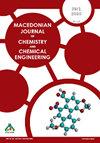布洛芬钠和对乙酰氨基酚负载纳米纤维的抗菌和抗生物膜活性
IF 1.1
4区 化学
Q3 CHEMISTRY, MULTIDISCIPLINARY
Macedonian Journal of Chemistry and Chemical Engineering
Pub Date : 2023-05-15
DOI:10.20450/mjcce.2023.2584
引用次数: 0
摘要
近年来,纳米纤维由于具有控制释放、透气性强、比表面积大、基质轻等优点,在各种医疗用途中发挥着越来越重要的作用。在本研究中,聚乳酸(PLA)-明胶(凝胶)纳米纤维通过静电纺丝成功地负载了布洛芬- na /扑热息痛(以下分别为Ibu-Na和Par)。采用扫描电子显微镜(SEM)和傅里叶变换红外光谱(FTIR)对纳米纤维进行了表征。采用高效液相色谱法测定了纳米纤维中Ibu-Na/Par的含量。对粪肠球菌ATCC 29212、金黄色葡萄球菌ATCC 25923、大肠杆菌ATCC 25922、铜绿假单胞菌PA01等常见致病菌进行抑菌试验。此外,还研究了它们对铜绿假单胞菌和粪肠杆菌的抗菌活性。含有ibu - na的纳米纤维对金黄色葡萄球菌、大肠杆菌和粪肠杆菌具有抗菌活性。结果表明,PLA-Gel-Ibu-Na 300对粪肠球菌、金黄色葡萄球菌和大肠杆菌的抑制带直径分别为23.0±2.1 mm、18.0±1.5 mm和12.0±1.2 mm。结果发现,PLA-Gel-Ibu-Na 300和PLA-Gel-Par 300纳米纤维对铜绿假单胞菌的生物膜形成抑制作用显著,分别为48%和50.4%。本研究表明,Ibu-Na/ par负载纳米纤维是一种很有前景的伤口愈合材料。本文章由计算机程序翻译,如有差异,请以英文原文为准。
Antibacterial and antibiofilm activities of sodium ibuprofen- and paracetamol-loaded nanofibers
Nanofibers loaded with pharmaceutical agents for various medical purposes have become more important in recent years because of their advantages, such as control on release, gas permeability, high surface area, and lightweight matrices. In the present study, polylactic acid (PLA)-gelatin (Gel) nanofibers were successfully loaded with Ibuprofen-Na/Paracetamol (henceforth Ibu-Na and Par, respectively) by electrospinning. The nanofibers were characterized by scanning electron microscopy (SEM) and Fourier transform infrared (FTIR) spectroscopy. The Ibu-Na/Par content of the nanofibers was determined by using high-performance liquid chromatography (HPLC). Their antibacterial activities were tested against Enterococcus faecalis ATCC 29212, Staphylococcus aureus ATCC 25923, Escherichia coli ATCC 25922, and Pseudomonas aeruginosa PA01, opportunistic pathogenic bacteria which are frequently associated with infections. Moreover, their antibiofilm activities against P. aeruginosa and E. faecalis were also investigated.
The Ibu-Na-containing nanofibers exhibited antibacterial activity against S. aureus, E. coli, and E. faecalis. The inhibition zone diameters of PLA-Gel-Ibu-Na 300 against E. faecalis, S. aureus, and E. coli were calculated to be 23.0 ± 2.1 mm, 18.0 ± 1.5 mm, and 12.0 ± 1.2 mm, respectively. It was found that PLA-Gel-Ibu-Na 300 and PLA-Gel-Par 300 nanofibers’ capacity to show biofilm formation inhibition originated remarkable effects on P. aeruginosa, which were found to be 48 % and 50.4 %, respectively.
This study indicated that Ibu-Na/Par-loaded nanofibers are promising materials for wound healing applications.
求助全文
通过发布文献求助,成功后即可免费获取论文全文。
去求助
来源期刊
CiteScore
1.60
自引率
20.00%
发文量
14
审稿时长
>12 weeks
期刊介绍:
Macedonian Journal of Chemistry and Chemical Engineering (Maced. J. Chem. Chem. Eng.) is an official publication of the Society of Chemists and Technologists of Macedonia. It is a not-for-profit open acess journal published twice a year. The journal publishes original scientific papers, short communications, reviews and educational papers from all fields of chemistry, chemical engineering, food technology, biotechnology and material sciences, metallurgy and related fields. The papers published in the Journal are summarized in Chemical Abstracts.

 求助内容:
求助内容: 应助结果提醒方式:
应助结果提醒方式:


